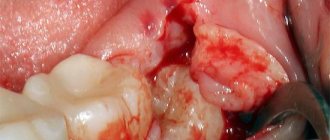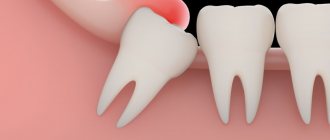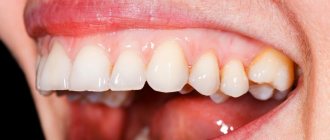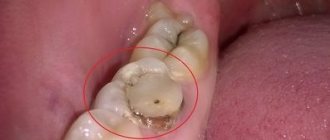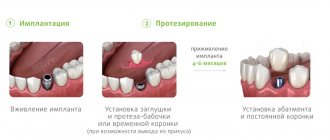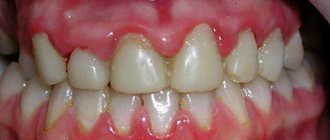Dental implantation is one of the best methods for restoring lost teeth and allows you to completely restore the anatomical and physiological features of the structure of the dentofacial apparatus. Despite the fact that dental implantation today is performed at a high quality level and is devoid of any disadvantages, sometimes patients still encounter some problems.
One of them is a change in the color of the gums near the dental implant. The Apex dental clinic uses dental implants from the world's leading manufacturers. They boast of their characteristics and allow you to achieve all your treatment goals.
The clinic’s experienced doctors do not make mistakes in their work, which guarantees impeccable quality of dental services with no negative consequences after the installation of dental implants.
And since doctors at the Apex dental clinic are often asked the question of why the gums near the dental implant turn black, today we will talk about exactly this, paying attention to ways to prevent the development of such a complication. Let's start, perhaps, by identifying the possible causes of darkening of the gums after installation of the implant.
Causes of gum darkening after implant installation
Successful implantation of dental implants is achieved at the Apex dental clinic in more than 90% of cases. Our patients almost never encounter the problem of subsequent darkening of the gums at the site of the installed dental implant, however, for many first-time visitors, this particular problem becomes the reason for seeking help.
Darkening of the gums after dental implant placement can have several causes. First of all, the quality of the selected implant is not high enough. In such situations, despite rapid healing, unpleasant symptoms (including darkening of the gums) may still occur.
Errors during dental implantation can also lead to the development of peri-implantitis. It is often caused by improper oral care after a successful operation.
Some chronic diseases, as well as bad habits, also increase the risk of developing peri-implantitis. Doctors at the Apex dental clinic always carefully analyze the condition of the patient’s teeth in order to issue correct recommendations for caring for a dental implant and inform about the possibility of unwanted symptoms.
Causes of darkening after implant installation
Hematoma
Darkening of the gums after implantation may be due to the formation of a hematoma. Hematoma is a common postoperative symptom, which is a natural reaction of the body to the presence of a foreign body. Most often it appears a few hours after implantation and goes away within a week. The hematoma reaches its greatest development on the fourth day after the intervention.
Blue discoloration on the gums can occur from an injection of anesthesia. With a favorable prognosis, such darkening is not dangerous and will disappear within a few days, like a hematoma.
Illumination of titanium elements
Even successful placement of dental implants can result in blue gums. When installing an implant and abutment, a blue highlight is possible; the blue color is especially clearly visible on the front teeth. To avoid such an unpleasant effect, when installing implants on the front teeth, you need to opt for zirconium abutments rather than titanium abutments.
Complications during prosthetics
Often darkening is observed after installing crowns on the implant. First, the gums turn red and swell, later they darken and bleed. The cause of the complication is an incorrectly formed gingival contour, if a former was not installed after the implant was implanted. The edges of the crown put pressure on the gum, disrupting blood circulation in it, causing swelling and blue discoloration. Stagnation of blue venous blood especially stands out against the background of white teeth and healthy areas of the gums.
What to do if your gums are darkened
Darkening is a sign that the installation of an implant or subsequent dentures has caused irritation and bleeding of the gums. Therefore, medication administration and monitoring should be carried out by a doctor.
Treatment is prescribed depending on the cause of the pathology. It may be necessary to adjust the implant superstructures or replace the crown or bridge fixation system. At the same time, the doctor will prescribe anti-inflammatory therapy. Massage and physiotherapeutic treatment methods are also indicated.
In case of color change, you should not self-medicate. Immediately contact a specialist to determine the pathology.
The most effective drugs:
- Rotokan . Black gums are rinsed with the solution three times a day.
- Metrogil Denta . Antibacterial gel is applied to the affected area for a month.
- Chlorhexidine bigluconate 0.5% . Rinse the mouth with the solution up to six times a day for several days.
- Vinylin . A compress with balm is applied to the darkened gum and kept for 20 minutes.
Before using folk remedies, consult your doctor because medicinal herbs have serious side effects.
The oral cavity is rinsed:
- a decoction of mint, sage, oregano, lemon balm;
- a decoction of St. John's wort, thyme, chamomile, sage;
- soda solution;
- hydrogen peroxide;
- sea salt;
- infusion of oak bark.
Comment from an implant surgeon with 12 years of experience: “Darkening can be caused by injury to blood vessels during implantation. If the operation is successful, there should be no severe pain, swelling or darkening. Standard complications: pain of moderate intensity, small hematomas, a feeling of fullness in the maxillary sinus, low-grade body temperature, inflammation of the soft tissue in the area of implantation, temporary bleeding.”
What to do if the gums near the implant have darkened
Answering this question, we immediately note that darkening of the gums near the implant and the occurrence of peri-implantitis are highly treatable and allow you to solve the problem in a short time.
Of course, as soon as you notice any changes in the area of the installed dental implant, you must immediately consult a doctor to determine the exact reasons for their development, make a diagnosis and carry out the necessary amount of treatment.
Already at the initial appointment, the doctor at the Apex dental clinic will conduct an objective examination and determine a further treatment plan. The specialist will tell you what you can do at home if the gums near the implant have darkened, and will also confirm whether the gums really turned blue after implantation - or in your case this is normal during the rehabilitation period.
A late visit to a specialist is fraught with the development of more serious complications, and therefore we strongly recommend not delaying your visit to the doctor.
How to treat tooth darkening
It is not always possible to correct darkening of the enamel. This is easiest to do when the cause is poor oral hygiene or smoking.
All that is needed in this case is professional cleaning.
There are also several other means:
- Treatment of caries. In this case, all work is standard - the dentist removes the damaged tissue, then fills the area.
- Silvering. Performed for fluorosis. In some cases, it helps to make the enamel lighter.
- Veneer installation. This method is more of a camouflage method than a therapeutic one. It is important to understand that sometimes the enamel remains in an altered state. In this case, all that remains is to install an overlay made of composite material or ceramics on it.
The final decision is made by the doctor after examination and medical history. The patient also bears a serious responsibility during treatment.
Sometimes it is necessary to change the diet, in other cases it is necessary to change the medications taken or improve oral hygiene.
After implantation, the gums turned blue: other symptoms and diagnosis of peri-implantitis
Regardless of the reasons that caused peri-implantitis, this disease can be characterized not only by changes in the color of the gums, but also by other symptoms. These include bleeding gums in the area of the dental implant, deformation of the gums in this area, mobility of the crown, as well as painful or uncomfortable sensations in this localization.
Only a dentist can diagnose peri-implantitis when conducting an objective examination of the patient’s oral cavity. As a rule, this complication is characterized by all signs of inflammation and may involve swelling and redness, a local increase in temperature in the soft tissues of the oral cavity, etc.
When contacting the Apex dental clinic, already at the initial appointment, the doctor will accurately determine the cause of darkening of the gums after installation of the implant,, if necessary, prescribe additional instrumental research methods (radiography), and also select an individual treatment regimen.
By choosing the Apex dental clinic, you are making a choice in favor of high-quality dentistry and a quick solution to all dental problems that arise!
Causes of darkening of enamel in children
In childhood, a number of reasons may include most of the above.
The child also often becomes a victim of an excess of fluoride and may not maintain oral hygiene or eat foods with strong coloring ingredients.
But among the leaders in the prevalence of causes in children, dentists name the following two:
- Injuries. They are received during games and activities. When the vascular bundles in the pulp are damaged, the enamel becomes darker.
- Medicines. Some drugs accumulate in the enamel. You should be especially careful with drugs of the tetracycline group.
How to care for your gums after implantation
After dental implantation, it is recommended to completely abstain from eating and drinking for two hours. Next, for 2-3 weeks, nutrition should be gentle, without consuming solid, excessively hot or cold foods.
One of the most important rules is to regularly rinse your mouth with prescribed antiseptic solutions, chamomile or other ingredients recommended by your doctor.
It is preferable to chew on the side opposite the suture, however, this recommendation will be individual for each patient. During the first 24 hours after the installation of dental implants, it is not recommended to brush your teeth, but in more detail about how to care for your gums after implantation, the doctors of the Apex dental clinic will tell you at your consultation.
Causes of tooth discoloration
Filling during the treatment of carious lesions, pulpitis or periodontitis is not always able to protect against the penetration of pathogenic bacteria or injury. This is most often due to medical errors during treatment, non-compliance with the rules of oral hygiene, injury to the jaw or an individual tooth.
Common causes of pathology:
- Penetration of pathogens under the filling and repeated carious lesions. Caused by shrinkage and aging of the filling, non-compliance with installation technology, and low-quality materials.
- Carious lesion of another part of the tooth.
- Development of the inflammatory process in the cavity and pulp necrosis.
- Incomplete pulp extraction, poor root canal sealing.
- Translucent metal pins and inlays.
- Disorders of calcium absorption and metabolism.
- Development of fluorosis.
- Traumatic injury.
- Taking Chlorhexedine or tetracycline antibiotics.
Several factors can influence the appearance of a dark shade of a tooth under a filling.
What causes a filling to change color?
Some patients experience changes in the shade of the filling. Blackening of the filling occurs due to various factors:
- Failure to comply with oral hygiene rules.
- Formation of abundant bacterial plaque or tartar.
- Excessive consumption of pigmented foods.
- Deposition of tobacco tar on the enamel due to smoking.
In rare cases, a filled tooth may appear darker after a professional cleaning or whitening procedure. Light-curing filling compounds are selected in a shade to match the color of natural teeth. During the whitening process, the color of the fillings does not change and they appear darker against the background of the rest of the row.
Caries on the side of the tooth near the gum: causes
The dominant cause of the occurrence and further development of caries on the side of the tooth near the gum is considered to be the presence of microorganisms of a cariogenic nature. Similar pathogenic bacteria exist and multiply on the surface of hard tartar and soft plaque.
The set of reasons for the formation and progression of caries on the side of the tooth near the gum includes:
- Dependence on the mode of food consumption, as well as the nature of food;
- Increased frequency of intake of foods containing easily fermentable carbohydrates;
- Pathogenic influence of microbial colonies contained in dental plaque;
- Formation by bacteria of the process of carbohydrate fermentation with the immediate creation of acidic layers that can have a destructive effect on enamel;
- The presence of foci of mineralization in the enamel structure;
- The presence of processes of leaching of fluorine, phosphorus, calcium;
- Violation of the structure of the enamel through a destructive effect on the mineral crystal lattice, which is accompanied by the appearance of carious spots;
- Ignoring the generally binding rules of systematic oral hygiene;
- Elimination of the correct implementation of the cleaning procedure of the dental surface, as well as the frequency and mode of the necessary process.
